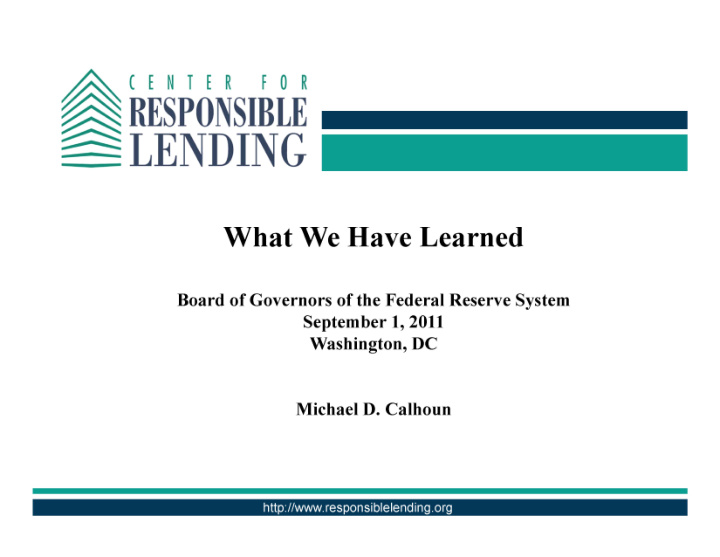



C E N T E R F O R Image of 3 horizontal bars laid one on top of the other, with a top-most, navy blue bar, a middle ^ R E S P O N S I B L E white bar, and a lower-most teal bar. Logo for the Center for Resonsible Lending. L E N D I N G What We Have Learned Board of Governors of the Federal Reserve System September 1, 2011 Washington, DC Michael D. Calhoun http://www.responsiblelendinq.org
Homes Prices in Real Terms Are Mean Reverting US Single-Family Market Cycles in 30 Years (1976Q1-2007Q1) The chart shows nominal home price growth rising from about 4% in 1976Q1 to between 14% and 16% in 1980. This nominal growth rate in home prices then drops fairly smoothly to 0% in 1983 and 1984. Nominal home price growth then rises from 0% in 1984 to about 8% in 1988 and back down to 0% from 1991 to 1995. From 1995 to 2006, nominal home price growth rises from 0% to 14%. Finally, from the middle of 2005 to the first quarter of 2007, home price growth drops from 14% down to 0%. The graph also aggregates real price growth and notes how periods of real price growth are generally followed by periods of real price decline. This is what is meant by the title: “home prices in real terms are mean reverting.” From 1976 to 1980, real prices rose 16%. Then, from 1980 to 198real prices fell 15%. From 1985 to 1990, real prices rose 17%. Then, from 1990 to 1998, real prices fell 16%. Finally, real prices rose 80% from 1998 to 2006. The implication is that real prices at this point are extremely overvalued and this explains the real price decline that has occurred since the beginning of 2007 – something that is beyond the time period of this graph.
m p a c t O n C o n s u m e r F i n a n c e s From 1991Q1 through 1998.4, while there is some variation, quarterly home equity extraction tends to average between $25 billion and $30 billion. Quarterly net equity extraction then rises relatively smoothly to more than $200 billion in the first quarter of 2006 before falling rapidly to less than $10 billion in the second quarter of 2008. From 1991Q1 through 1998.4, while there is some variation, quarterly home equity extraction tends to average between 1.5% and 2% of disposable income. Quarterly net equity extraction then rises relatively smoothly to more than 9% of disposable income in the first quarter of 2006 before falling rapidly to less than 0.25% percent of disposable income in the second quarter of 2008. The chart is sourced to the following URL: http://calculatedrisk.blogspot.com/.
Delinquency by Loan Type This slide, with a graph labeled “Delinquency by Loan Type,” details delinquency levels for six different mortgage loan types for the 5 year period from 2006Q1 through 2011Q1. The loan types are, from (generally) lowest to highest delinquency rates: 1. Prime Fixed Rate Mortgages; 2. FHA; 3. CAP; 4. Prime Adjustable Rate Mortgages; 5. Subprime Fixed Rate Mortgages; 6. Subprime Adjustable Rate Mortgages. The delinquency rate for Prime Fixed Rate Mortgages starts off around 1%, rises very gradually to about 5% in the first quarter of 2010 and then falls back modestly over the next 4 quarters. The delinquency rate for FHA Mortgages starts off at just under 6%, rises very gradually to about 8% in the fourth quarter of 2009 and then falls back modestly over the next 5 quarters. The delinquency rate for CAP Mortgages starts off around 2%, rises very gradually to about 8% in the fourth quarter of 2009 and then stays at this level over the next 5 quarters. The delinquency rate for Prime Adjustable Rate Mortgages starts off around 1%, rises very gradually to more than 15% in the fourth quarter of 2009 and then falls back to about 13% over the next 5 quarters. The delinquency rate for Subprime Fixed Rate Mortgages starts off around 6%, rises gradually to around 20% in the fourth quarter of 2009 and then falls back to about 18% over the next 5 quarters. The delinquency rate for Subprime Adjustable Rate Mortgages starts off around 6%, rises to around 42% in the fourth quarter of 2009 and then falls back to about 36% over the next 5 quarters.
CAP Equity Accumulation This slide contains a chart with the title “CAP Equity Accumulation” that details CAP mortgage equity accumulation over the time period from January 2000 to the beginning of 2011. On the Y-axis is the median total equity accumulated since origination. The initial value for median equity accumulation is around $2,500 in January of 2000. This rises fairly smoothly to somewhere around $33,000 in early 2007 as home prices spike. The median equity accumulation level then falls from this high level to just over $20,000 in the beginning of 2011. The implication from this chart is that even with the rapid decline in home price, the average CAP participant has still retained a signification amount of home equity appreciation; that is, CAP loans still are useful tools for building wealth for program participants.
Recommend
More recommend